
Unit English Plan
Teacher: Yelena Kozlova
Children’s club
Unit Information
· Theme: In the House
· Age of students: 10 years old
· Language level: First-year beginners
· Number of students in the class: 15 students
· Number of minutes for each class: 45 minutes
· Frequency of class: two days a week for two weeks
Core Vocabulary
1. bedroom, 2. bed, 3. closet, 4. lamp, 5. living room, 6. sofa, 7. chair, 8. TV, 9. kitchen, 10. table, 11. stove, 12. kettle, 13. sink, 14. bathroom, 15. mirror
Grammar Component
Prepositions of place (in, on, under, in front of, behind)
Rationale
The main aim of this unit theme is the recognition of the studied propositions of place and the core vocabulary. To learn about the parts of the house, the appliances and the furniture is important because they are everyday life realia; so that, all the core vocabulary is related to the students’ context. In the case of prepositions, these are helpful to understand the relationships between persons, objects, and locations. Prepositions also act as vital markers to the structure of a sentence.
Learning Objectives
· Listening: Listening to at least 5 short sentences related to the location of some pieces of furniture and appliances into the different parts of the house, students will be able to memorize the core vocabulary and the prepositions of place with 80% of accuracy.
· Reading: Using a given worksheet, students will be able to read aloud with 80% of accuracy descriptions about the location of some pieces of furniture, appliances and parts of the house studied prepositions of place.
· Speaking: Using the following grammatical structure: “It’s _______ the ___________” while seeing flashcards or images with the location of some pieces of furniture and appliances into the different parts of the house, students will be able to answer orally to the following question “Where is the _____?” with 80% of accuracy.
· Writing: Using a given worksheet and the following grammatical structure: “It´s ____ the ________”, students will be able to complete with 80% of accuracy at least 5 sentences based on the location of some pieces of furniture and appliances seen on images of the different parts of the house.
Prior Knowledge
“Their pre-existing knowledge acts as a foundation on which they can build new knowledge and helps them connect what they are learning to what they know already.” (Mindsteps, n.d.). For these theme-based lesson plans, the prior or background knowledge that students have about the topic (parts of the house, furniture, appliances and preposition) is important determine the what teaching strategies to use. For these lesson plans, some of the activities use for activating the prior knowledge are: video clips, stories and games.
Learning Styles
· Visual–Students, who are visual learners, learn better by reading or seeing pictures. Based on Shoebottom (n.d.), “usually enjoy reading and prefer to see the words that they are learning. They also like to learn by looking at pictures and flashcards.” In the case of these lesson plans, the visual learning style is promoted through the use of posters, flashcards and worksheets for performing reading.
· Auditory–Students, who are auditory learners, learn easier by hearing and listening. “They enjoy conversations and the chance for interactions with others. They don’t need to see words written down” (Shoebottom, n.d.). For purposes of these lessons, activities as reading out loud flashcards and worksheets.
· Kinesthetic–Students who are “Kinesthetic learners like movement and need frequent breaks in desk activities” (Shoebottom, n.d.). These type of leaners learn better by doing (touching, moving, drawing, building, performing mimics, etc.). For these plans, kinesthetic activities include pointing out pictures, racing and coloring, just to mention some.
Challenges and Proposed Solutions
Challenge # 1. Students have different socio-economical background. Some learners' homes do not have the all the rooms proposed in the core vocabulary; and the studied furniture and appliances. There is not easy electronical access in all the places around the world.
Solution # 1. We can show a video of the houses with these rooms and items to make them tangible to the students and make them real to their imaginations.
Challenge #2. Some teachers use grammar translation as a teaching approach or use their mother language to explain vocabulary and grammar. So that, language is learnt by rote and less communicative.
Solution #2. More communicative activities can be done during lesson plans. Lessons should not only be fun, but also include authentic material and activities in order to make language worthier and useful for daily life situations.
Challenges #3. Lack of economical, technological and didactical resources in some schools.
Solution #3. Some schools do not have the same economical, technological and didactical resources. In some schools, there are not enough classrooms, teachers and/or technological equipment; so that, in those cases activities must be adapted for each learners’ environment and reality.
Challenges #4. Management behavior and classroom discipline during each lesson. Sometimes, to manage behavior with 30 students is so difficult; specially for the learners’ span time.
Solution #4. Activities should be fun and short; these must be constantly changing. All the rules must be known and given to the students since the first lessons. Activity rules have to state it as clear as possible.
Assessment Strategies
As assessment can be done before, during and after the implementation of teaching approach or strategy. For purposes of these theme-based unit plans; the diagnosis assessment could be done through the warm-ups; specially from those activities that show the students’ prior knowledge, as the brainstorming. In the case of the assessment done during the process, this will be measure by observation and records. Finally, the final evaluation can be measure by the results got from the worksheets.
Lesson Plans
Lesson 1
|
Language Learning Objectives |
· Listening: Listening to at least 5 short sentences related to the location of some pieces of furniture and appliances into the different parts of the house, students will be able to memorize the core vocabulary and the prepositions of place with 80% of accuracy. · Speaking: Using the following grammatical structure: “It’s _______ the ___________” while seeing flashcards or images with the location of some pieces of furniture and appliances into the different parts of the house, students will be able to answer orally to the following question “Where is the _____?” with 80% of accuracy. |
||
|
Materials needed |
· board · house poster · chalk or white board (depending on the used board) |
· flashcards · rooms small posters · masking tape · 30 worksheets (one per student) |
· 1 marker (for using it with the small posters) · small and soft ball |
|
|
|
||
|
Activity and Time |
Description of Activity |
||
|
Daily Routines 5 min |
The teacher will: · greet the students · call the roll (Annex 2) · ask for the date and the weather condition of the day |
||
|
Warm up 5 min |
Brainstorming: · Students will observe a house poster (appendix 3) pasted by the teacher on the board and make up with some word related chosen the shown house’s rooms. The teacher will write the words said by the students on the board; if words are saying in another language. |
||
|
Presentation 8 min |
Observing images: · Students will observe flashcard with related to preposition of place (Appendix 4) and small posters of studied parts of the house (appendix 5) and repeat the preposition and the core vocabulary after the teacher while performing mimics. In the case of the small posters, the teacher can point out or circle with a marker the furniture and appliances from the core vocabulary. The teacher will model the studied grammatical structure. |
||
|
Controlled Practice 5 min |
Asking Time: · Students, by turns, will answer to the following question “Where is the _____?” using the following grammatical structure: “It’s _______ the ___________” while they observe the small posters of the rooms. The teacher will choose the student for each answer, show the flashcard and make the question. For making this activity more interactive, students have to catch one small and soft ball the teacher will throw for asking the questions. After each student answer, he or she has to throw it back to the teacher. |
||
|
Free Practice 10 min |
Asking Others: · Students make a chain of questions. Using the ball, the teacher will throw the ball to one student in order to answer the following question “Where is the _____?” while the teacher point to one of the small posters. The student who is asked has to answer using the following grammatical structure: “It’s _______ the ___________”. After the student answers the question, he or she throw the ball to another student and make the same question made by the teacher. In this case, the student makes the question, but the teacher points out the image. |
||
|
Homework 5 min |
Coloring and filling the gaps based on furniture and appliances: · Students will get a worksheet with and image of a room of a house (appendix 6). The teacher will explain that students have to color, as homework, a bedroom and a kitchen by using images of different furniture and appliances. |
||
|
Closing activity 2 min |
The teacher will: · say good bye to the students. |
||
|
Total Minutes = 45 |
|
||
Lesson 2
|
Language Learning Objectives |
· Reading: Using a given worksheet, students will be able to read aloud with 80% of accuracy descriptions about the location of some pieces of furniture, appliances and parts of the house studied prepositions of place. · Writing: Using a given worksheet and the following grammatical structure: “It´s ____ the ________”, students will be able to complete with 80% of accuracy at least 5 sentences based on the location of some pieces of furniture and appliances seen on images of the different parts of the house. |
|
|
Materials needed |
· 1 small and soft ball · small posters · board |
· worksheets for the matching game · worksheets for the writing activity · homework duplicates |
|
|
|
|
|
Activity and Time |
Description of Activity |
|
|
Daily Routines 5 min |
The teacher will: · greet the students · call the roll · ask for the date and the weather condition of the day · collection and checking homework with the students. |
|
|
Warm-up 5 min |
Hot potato: · Students will play the game named “Hot Potato” using the same soft ball use in the previous lesson. In this activity, the teacher will clap in order to see who gets the ball. When one of the students gets the ball, he or she has to answer to the following question. “Where is the ______?”. The student has to answer using the following grammatical structure: “It’s ___ the ___” based on the small posters used in the previous lesson (Appendix 5). |
|
|
Presentation 2 min |
Preposition of place presentation: · The students will pay close attention to the teacher’s input. The teacher will write the question “Where is the ______?” and the sentence: “It’s ___ the ___” on the board. The teacher will explain how to use them using the small posters from the previous class. |
|
|
Matching Game 15 min |
Classifying based on preposition of place: · On pairs, students will try to classify through the matching game different pieces of furniture and appliances based on the proposition of place by using a provided worksheet (Appendix 7). The teacher will be checking the correct performance and asked students to read the answers aloud. |
|
|
Writing time 13 min |
Completing written sentences: · Students will complete individually 5 sentences using the provided worksheet (Appendix 8). The teacher will be checking the correct activity performance. |
|
|
Homework 4 min |
Drawing furniture and appliances: · Students will get a worksheet with and image of a house (appendix 9). The teacher will explain that students have to draw, as homework, a bathroom and the living room by using images of different furniture and appliances. |
|
|
Closing activity 1 min |
The teacher will: · say good bye to the students. |
|
|
Total Minutes = 45 |
|
|
Lesson 3
|
Language Learning Objectives |
· Listening: Listening to at least 5 short sentences related to the location of some pieces of furniture and appliances into the different parts of the house, students will be able to match the core vocabulary and the prepositions of place with 80% of accuracy. · Speaking: Using the following grammatical structure: “It’s _______ the ___________” while seeing flashcards or images with the location of some pieces of furniture and appliances into the different parts of the house, students will be able to answer orally to the following question “Where is the _____?” with 80% of accuracy. |
|
|
Materials needed |
· Small posters · Computer · TV or video beam · Video · House poster · Room small posters |
· Resource box for core vocabulary words. · Resource box for preposition of place flashcards. · Tape · Chalk or white board. |
|
|
|
|
|
Type of Activity |
Description of Activity |
|
|
Daily routine 5 min |
The teacher will: · greet the students. · call the roll. · ask for the date and weather condition for the day. |
|
|
Warm up 4 min |
Watching a video: -Students will observe the following video: https://www.youtube.com/watch?v=sE2GEaQJrwc |
|
|
Review 6 min
|
Watching a video: · Students will watch the video from the warm up activity. However, during the second time, the teacher will stop the video and the students have to name the vocabulary they remember (especially the one found in the core vocabulary) and studied prepositions of place. |
|
|
Presentation 7 min |
Listen and repeat: · The teacher will point at poster house (Appendix 3) and say aloud some sentences like this: - “This is my house; this is your house. It has four rooms. 1, 2, 3, 4 rooms. Bedroom, living room, bathroom and kitchen, not chicken.” · After that, the teacher points at the small room poster (Appendix 4) and say aloud: - “Living room. The sofa is in front of the table. Kitchen, the stove is in the kitchen. The bedroom, the mirror is on the table. The bathroom, the sink is in the bathroom.” · For this presentation, the teacher will also perform mimics, especially related to the prepositions mention. |
|
|
Team Work 15 min |
Race Time: The teacher will: · Divide students in groups of 5 and tell the students what to do. · Paste the posters on the chalkboard. The students will: · Use the resource boxes for vocabulary and prepositions, take one flashcard from each box. The after the teacher says Go, the student will look at the preposition, then look at the vocabulary she/he has chosen and run to the chalkboard to place it in an appropriate position. This activity will be timed by students shouting 1 up to 5. When the time is over and the student hasn’t finished, the other students will shout, ‘NEXT TIME’ and the other group will take charge. When student has done the correct thing within time the students will shout, “SHINE” |
|
|
Homework 5 min |
· The teacher explains the homework assignment given to the students. In this one, students have to draw the different parts of the house: kitchen and bedroom. (Appendix 10) |
|
|
Closing activity 1 min |
The teacher says good bye to students |
|
|
Total Minutes = 45 |
|
|
Lesson 4
|
Language Learning Objectives |
· Speaking: Using the following grammatical structure: “It’s _______ the ___________” while seeing flashcards or images with the location of some pieces of furniture and appliances into the different parts of the house, students will be able to answer orally to the following question “Where is the _____?” with 80% of accuracy. · Writing: Using a given worksheet and the following grammatical structure: “It´s ____ the ________”, students will be able to complete with 80% of accuracy at least 5 sentences based on the location of some pieces of furniture and appliances seen on images of the different parts of the house. |
|
|
Materials needed |
· House poster · Room small posters · Chalk or white board. · Tape
|
· House template (homework assignments) · Worksheets |
|
|
|
|
|
Type of Activity |
Description of Activity |
|
|
Daily routine 5 min |
The teacher will: · Greet the students. · Call the roll · Ask for the date and weather condition for the day. |
|
|
Warm up 6 min |
Thumbs Up-Thumbs Down: · The teacher will continue using the posters from the previous lessons (Appendix 3 and 5). The teacher will ask question to the students related to the posters. E.g. “Where is the mirror? It’s IN living room.” In this case, as the answer is wrong, students have to give thumbs down. If the questions and the answer are correct, thumbs should be up. E.g. “Where is the table? It’s IN the kitchen.” |
|
|
Presentation and Review 8 min |
· The teacher will make an oral review of the previous lessons; giving special emphasis to questions and sentences (including grammatical structures; questions and answers) |
|
|
Practice 15 min |
Show and tell: · The students will be divided in 6 subgroups (around 5 members per subgroup). Each member chose one of the house templates (from appendixes 9 and 10) by using the grammatical structure, he or she has to answer to the questions made by their classmates: “Where is the ____________?” |
|
|
Writing Time 10 min |
· Using worksheets (1 per student), students based on the house template they did have to write at least 5 sentences. (Appendix 11) |
|
|
Closing activity 1 min |
The teacher says good bye to students |
|
|
Total Minutes = 45 |
|
|
Appendixes
Appendix 1.
Activating Strategies for Use in the Classroom
|
Written Activating Strategies |
Brief Description of the Strategy |
|
3-2-1 |
List: 3 things you already know about X, 2 things you’d like to know about or learn more about, and 1 question related to the key concept or learning. |
|
KWL |
Begin the lesson with a three-column organizer: What I Know, What I Want to know, what I Learned. Have students fill in the first two columns in advance of the lesson. Return to the last column as a summarizing strategy for the lesson. |
|
Admit/Entrance Ticket |
This can be any “query” that prompts students’ interest/engagement in relation to the focus of the upcoming lesson. It can serve to bring background knowledge to the forefront, make connections with the previous day’s lesson, and/or generally get students to focus their thinking on the specific consideration of that day’s learning. |
|
Questions to the Teacher |
Have students list 3 (or any number) of questions they would like to pursue in relation to the focus of the lesson. |
|
Acrostics |
Give students the key word/concept which will be addressed in the lesson. Ask them to write a detail or descriptor with which they are already familiar that starts with each of the letters of the key word/concept |
|
Carousel Brainstorming |
On chart paper around the room (or on paper that is passed around groups), ask small groups of students (3-4) to respond to a question or statement posed at the top of the paper. (These questions/statements should represent components of their upcoming learning.) After a short period of time, student groups move on to another piece of chart paper/topic, and read what has been written about that topic and add to or respond to it. Key reminder: Ahead of time prepare the chart paper and the different topics, insuring that you have enough “stations” so that every group is at one station during each rotation. These charts and responses can be used as the lesson activator, representing the prior knowledge and current understandings of the group. |
|
Activating Gist/Word Association |
Students are given a grid of blanks (any number, depending on the age/level of the student and the level of complexity of the topic). Invite them to fill each blank with a word or phrase which they think of in relation to the lesson topic or lesson essential question. The words they record will capture the “Gist” of their prior knowledge or preconceived thinking. Journals If students keep journals for the course, have the activating strategy be an entry in the journal in response to a prompt related to the focus of the lesson. |
|
Anticipation Guide |
Provide students with 5-10 statements about the topic of the lesson. (There should be two response columns, one for before and after the lesson.) As the activating strategy, have students respond in the first column, basing their answers on their prior knowledge or predictions about the statement. Return to the Anticipation Guide at the end of the lesson and have students respond again, this time in the “After” column, as the summarizing strategy for the lesson. |
|
Think-Pair-Write |
Similar to Think-Pair-Share, students are given a topic/question related to the upcoming lesson, they brainstorm it with a partner, but then each student writes his/her own response. |
|
Think-Write-Share |
Similar to the above strategy, but the sharing follows the writing. Students think about a question related to the upcoming lesson, write a response, then share with their partners. |
|
Word Splash |
Students are given a “splash” of the key words from the lesson. They should write a few meaningful sentences to capture (relying on their background knowledge) using these words. |
|
Written Conversations |
Using a small segment of engaging text or an appropriate question or statement to prompt student thinking about the topic or concept of the upcoming lesson, ask each student to begin writing in response. After 2-3 minutes of writing, have them exchange their papers (or pass them around) and spend 1-2 minutes responding to the writing/thinking on the paper they receive. Then have them pass the paper back (or on to a third person) and continue the process. Limit the time, using a timer or other signal, so that students are always left thinking they have more to say. |
|
Dear ___________________, |
Have students write a letter or note to another person, character, political figure, etc. telling him/her something they know or think about the focus of the upcoming lesson or lesson essential question. |
|
Sentence Starters/Prompts |
Provide for students a sentence starter or prompt which requires them to complete the sentence or phrase. For example: One thing I already know about X is _______________, or One important thing I think about X is ___________________. |
|
Learning Logs |
If students keep learning logs for the course, let the activating strategy be an entry in the learning log (similar to journals). The prompt for the entry may be designed to help students make connections between the previous day’s lesson and the current lesson. |
|
Transformed Text - Concept Preview |
In advance of the lesson, the teacher transforms a text into a different genre. For example a section from a science or social studies text which will be read during the lesson may be transformed the information into any of the following: 1) newspaper article, 2) flyer or advertisement, 3) letter from a specific viewpoint (see RAFT), 4) diary entry, 5) comic strip, etc. Present this transformed text to the students as a concept preview for the upcoming text. Ask students to capture the main idea or key points from the transformed text on an index card. |
|
Frayer Model |
Use this “concept definer” graphic organizer at the beginning of a lesson, choosing a key concept from the lesson to explore. See: http://toolsfordifferentiation.pbworks.com/Frayer-Model Plus/Minus/Intriguing The teacher should write prompts, controversial statements, etc. (related to the focus of the upcoming lesson) ahead of time to which students will be asked to respond. Have them identify the statements they agree with (+), the statements they disagree with or question (-), and the statements they find intriguing (I). |
|
Alphabet Game |
Divide the alphabet among the class (or groups). Each student (or group) must think of one descriptor, fact, example, etc. about the topic or lesson essential question that begins with the letter she/she is assigned. Have them share with the entire class. |
|
Concept Map/Word Map |
A great way to introduce and gather background knowledge about a complex topic or sophisticated concept: Have students use a graphic organizer to record what they know or believe about, 1) what the concept/term is (definition), 2) what it’s like (properties, qualities), 3) examples, and 4) non-examples. Be sure to return to the map at the end of the learning experience to revise with new knowledge and understanding. See: http://www.readingquest.org/strat/cdmap.html 5-3-1 (alone, pair, group) Pose a question/topic related to the focus or essential question of the upcoming lesson. Then have students individually brainstorm 5 answers. Then they work in a pair to come up with the 3 best. Then the pair joins with another pair to come up with the 1 most important. |
|
Sticky Notes |
Give students sticky notes and a question or topic (related to the upcoming lesson) to which they should respond. Have them post their notes on the board, door, wall, or a chart (that can have divisions/pros/cons, etc.). Students will return to those responses at the end of the lesson to confirm or revise their thinking. |
|
Give One-Get |
One Pose a question/topic connected to the focus of the lesson. Have students number their papers to 5. They should write 3 ideas/answers. Then they must talk to at least 2 more students to “get” 2 additional answers and to “give” 2 of their answers to their classmates. |
|
Quick Writes |
Pose a question or specific aspect of focus for the upcoming lesson. Ask students to “quick write” (write whatever comes to mind about the topic, without regard to written conventions—a brainstorming on paper) for a limited amount of time. Begin with short time periods of 1-2 minutes, because students must write the entire time. |
|
Cloze Activity |
To preview upcoming vocabulary and assess prior knowledge, provide students with key terms/words they will be encountering in the lesson and a paragraph about the topic with blanks that they should try to complete from the given list of terms. |
|
Alphabet Sequential Round Table |
Give students a grid with each letter of the alphabet in a square. In a small group, students are given a defined time to begin filling in the grid with a word or phrase that starts with the letter in the grid and which relates to the key learning of the lesson. At the signal, the student passes the grid on (and receives another). With each successive pass, students must read the concepts/ideas on the grid they receive, and then continue completing the grid, adding (not repeating) new information to each grid. At the end of the lesson, students should revisit and add to the grid with their new understandings. |
|
Snowball Fights |
Write preconceived notions on separate pieces of paper (these could be like the controversial statements you might include on anticipation guides), with enough pieces of paper so that every student receives one (you may have multiple copies of each notion). Ask students to respond to the statement on their paper, but not to put their names on their papers. Then they wad up the paper and toss the “snowball” (either in a box or to a designated center spot). Then each student in the class gets one of the tossed snowballs. Students then look at the snowball they received and respond to the prompt (set a time limit of 1-2 minutes tops for the response). They should then wad up the paper again and toss it, repeating the process again. Then, after the students respond to their second snowball, they should form groups of 4 to share both the preconceived notions or topics and the student responses. |
|
“How Do You . . . ?” |
With any skill that is a process, as a review ask students individually or in pairs to write down the steps they believe are involved. Have students return to this activating strategy at the end of the lesson to revise, based on their new learning. |
|
Non-Written Activating |
Strategies Brief Description of the Strategy |
|
Read and Say Something |
Have students read a portion of text and then “say something” to their partners in response to their reading. This can also be done in the forms of questions, where students read a portion of the text and then pose questions about what they have just read. |
|
Turn and Talk |
In response to a prompt or question, direct students to “turn and talk” to a shoulder partner (very similar to Read and Say Something). |
|
Think-Pair-Share |
Pose a question related to the upcoming lesson to the group. Allow time for students to individually process their thinking in response to the question. Then ask them to discuss with their collaborative partners (pairs) and then share with the group or with another pair. |
|
Numbered Heads Together |
To gather and build background knowledge in small groups, have Collaborative Pairs “square” to form groups of 4. In each group, tell them to number themselves 1, 2, 3, and 4. Meanwhile, you assign the groups letters (A, B, C, etc.). Tell them to pull their group’s chairs close so they can “put their heads together.” Pose the 1st question out loud. Then give them 2-3 minutes to quietly discuss the answer. When you signal time is up, everyone should be silent. Then randomly call a group letter and one number (e.g., A3 or C2 or D1, etc.) Whoever happens to be that number in the particular group – Person 3 in Group A, for example – must answer the question. If the question can be answered in more than one way, then you can call another letter and number to get additional responses. |
|
Quick Talk |
Establish a specified time frame (1-2 min., perhaps using a timer to signal when time is up). Then, tell students to engage in “quick talks” to express their thinking/learning about an issue related to the upcoming lesson. (Could also say: “A talks for 1 minute, B talks for 1 minute.”) |
|
Charades/ Improvisation/Role Play |
Have students engage in dramatic creations that predict or anticipate the learning to come in a lesson. |
|
Stand the Line (1 step in, 1 step back) |
Put a piece of masking tape down the center of the classroom. Have students stand on either side of the tape, about two steps away. Pose a series of prompts for which students must take a stand. Direct students to take one step in/toward the line if they agree, or one step back from the line if they disagree. Randomly ask given students to share their thinking verbally. This is a kinesthetic version of an anticipation guide. |
|
Red Light, Green Light |
In an open area of the classroom or hallway, engage students in the childhood game of Red Light, Green Light. When you turn as they freeze, ask one of the participants to respond to a question/prompt related to the focus of the day’s lesson. If they are unable to do so, they must return to the starting line. The first student to reach you must make a prediction related to the upcoming learning or forfeit his “win” and start all over. |
|
Kinesthetic Tic Tac Toe |
Draw or outline with masking tape a large tic tac toe grid on the floor (you will need to have each square about 3 X 3 or 4 X 4). Create a paper version of the grid with different prompts for the given content of an impending lesson in each square. Distribute the paper Tic Tac Toe grids to students and tell them that when you give the signal (clapping hands, flicking lights, etc.), they are to step into a square with 1-2 other people and converse with each other in response to the prompt in that square on their paper. Each time they hear/see the signal, they should move to different blocks, with different people and respond to the prompts for those blocks. Repeat the process until students have had multiple opportunities to reflect about the different aspects of the content. (Note: Be sure to establish where the top of the grid on the floor is in relation to the top of the paper version.) |
|
Illustration/ Drawing/ Cartoon/ Tattoo |
Have students create an illustration, drawing, or cartoon to describe what they already know about the new topic or concept. Story Board Give students a blank “story board” and ask them to create a non-linguistic version of what they already know about the topic/essential question for an impending lesson, filling the blocks of the story board with stick figures, drawings, etc. in an appropriate sequence. |
|
Smiley Faces, Sad Faces or Red or Green Cards |
As a really quick assessment of prior knowledge, have the students make index cards with smiley faces on one side and sad faces on the other, or one side red and one side green. The teacher then can pose a series of questions and have students quickly indicate by holding up or flashing the appropriate side of the card to reflect their thinking. |
|
Thumbs Up, Thumps Down |
Similar to the objective of the Smiley Faces above, student just give a thumbs up or down sign, close to their chests, to indicate their response. |
|
Following Directions |
Have students guide their partners through specific steps or processes by giving detailed directions that the partner must follow explicitly. This might be modeled in a fun way using the old “making a peanut butter sandwich” game, where one person gives directions for making a peanut butter sandwich and the partner has to just the steps dictated. This is an effective activating strategy to lead into a process lesson. |
|
Read Alouds |
Utilizing a well-established, research-based instructional practice, do s a read aloud of a children’s book, anecdote, parable, or other text sample that provides an insight or analogy appropriate for the focus of the impending lesson. (e.g., a read aloud of Dr. Seuss’s The Lorax to activate thinking for a lesson about environmental responsibility; a read aloud of Sir Cumference and the Great Knight of Angleland by Cindy Neuschwander and Wayne Geehan to activate thinking in relation to a lesson on angles.) |
|
Photo Sort |
Provide/Project a collection of photographs about the topic of the upcoming lesson. Ask students to sort the photographs by predicted sequence or by subtopics (e.g., photographs of a historical period which students will be learning about might be sorted by what seems to be the logical sequence of events; photographs of various polygons might be sorted by common number of sides, etc.) |
|
Video Clips |
Use a brief video clip on a pertinent topic, theme, or occurrence to activate student interest in the focus of an upcoming lesson. |
|
Meet and Greet (or “going to a ‘Math’—or other content-- party” or “Speed Dating”) |
Ideal for a vocabulary preview or concept preview, each student is given 1 word or term to learn about (and write on an index card or perhaps do a Frayer). Then the teacher models how a person would introduce him or herself to a stranger in professional, polite conversation. The introductions in this “meet and greet” are actually the vocabulary terms being introduced and discussed. As in interpersonal conversation, the parties ask each other questions about themselves, etc. The idea is that the students go around the room, meeting and greeting all the different people/terms in the classroom. |
|
Twenty Questions |
Display an initial clue about the topic or key concept from the upcoming lesson. Tell students that they may ask “twenty questions” which require a yes/no response in order to figure out what that topic/concept might be. |
Compiled by Ann Lewis, Laurel School District; and Aleta Thompson, Cape Henlopen School District; September 2010 2
Appendix 2.
Creative Roll Call Ideas
The teacher will write or ask the students to answer questions (use the ideas below) while the teacher call the ro
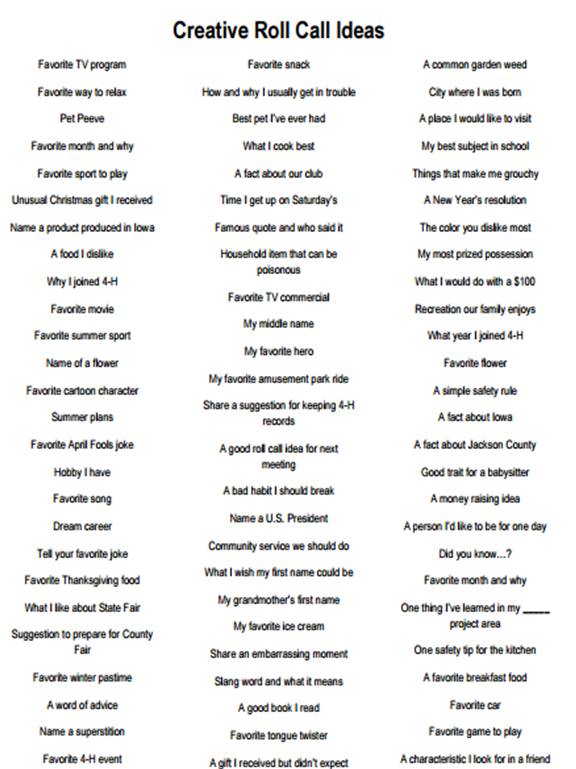
Appendix 3.
House Poster
This image will be
expanded in order used on the board.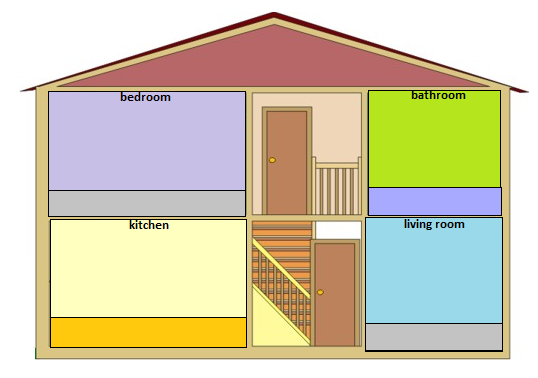
Appendix 4. Preposition of Place Flashcards

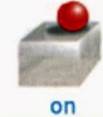
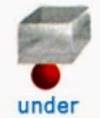
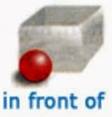
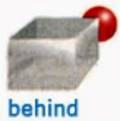
Note: Expand these images as necessary for using them as flashcards.
Appendix 5. Rooms Small Posters
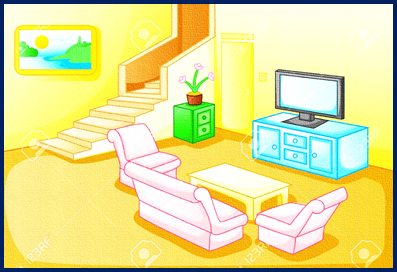
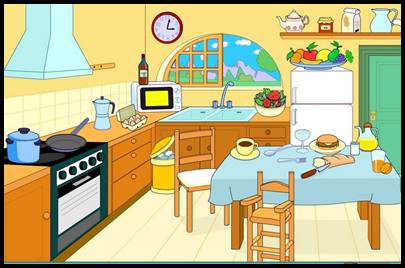
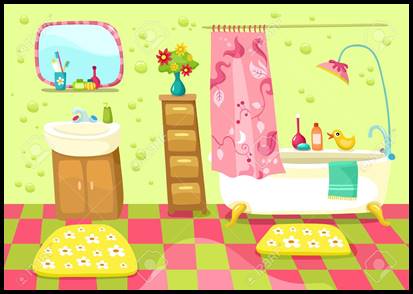
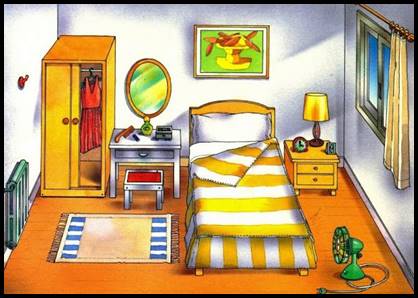
Note: These images will be big enough to match the house poster
Appendix 6.
Homework assignment 1
Color and filling the blanks using the names of the parts of the house.
![]()
![]()
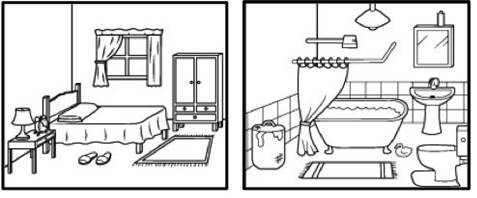
![]()
![]()
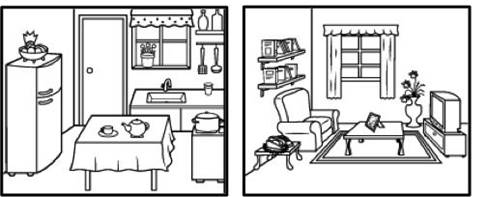
Appendix 7. Matching Game Worksheet
Name. _______________________________________ Date: ____________________
Matching Game
In my house… Where is it?
Match each sentence with the picture using lines
1.
 It’s
ON the TABLE
It’s
ON the TABLE
2.
 It’s
UNDER the TABLE
It’s
UNDER the TABLE
3. It’s IN the CLOSET
 |
4.
![]() It’s
IN FRONT OF the TABLE
It’s
IN FRONT OF the TABLE
 |
5. It’s BEHIND the TABLE
 |
|||||
Appendix 8. Completing Written Sentences
Name. _______________________________________ Date: ____________________
Writing Activity
In my house… Where is it?
Complete the sentences using prepositions of place based on the pictures. Use the word bank. Words CANNOT be repeated.
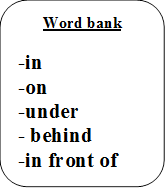 |
|||
 |
|||
1. It’s _________ the TABLE.
 |
2. It’s _________ the TABLE.
 |
3. It’s ____ the CLOSET.
 |
4. It’s ___________ the LAMP.
 |
5. It’s _________ the SOFA
Appendix 9.
Homework Assignment 2
Look in magazines, newspaper or just draw and image and write its location in each room




Appendix 10.
Homework Assignment 3
Look in magazines, newspaper or just draw and image and write its location in each room




Appendix 11.
Completing Written Sentences
Name. _______________________________________ Date: ____________________
Writing Activity
In my house… Where is it?
 Complete the sentences
using prepositions of place based your house templates. You can use the words
around.
Complete the sentences
using prepositions of place based your house templates. You can use the words
around.
1. Where is the ________________?
It’s _________ the __________.


2.
 Where
is the ________________?
Where
is the ________________?
 It’s
_________ the __________.
It’s
_________ the __________.
3.
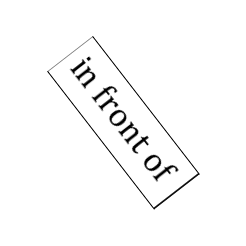 Where
is the ________________?
Where
is the ________________?
 It’s
_________ the __________.
It’s
_________ the __________.
 |
4.
 Where
is the ________________?
Where
is the ________________?
It’s _________ the __________.


5.
 Where
is the ________________?
Where
is the ________________?
It’s _________ the __________.
Скачано с www.znanio.ru
Материалы на данной страницы взяты из открытых источников либо размещены пользователем в соответствии с договором-офертой сайта. Вы можете сообщить о нарушении.